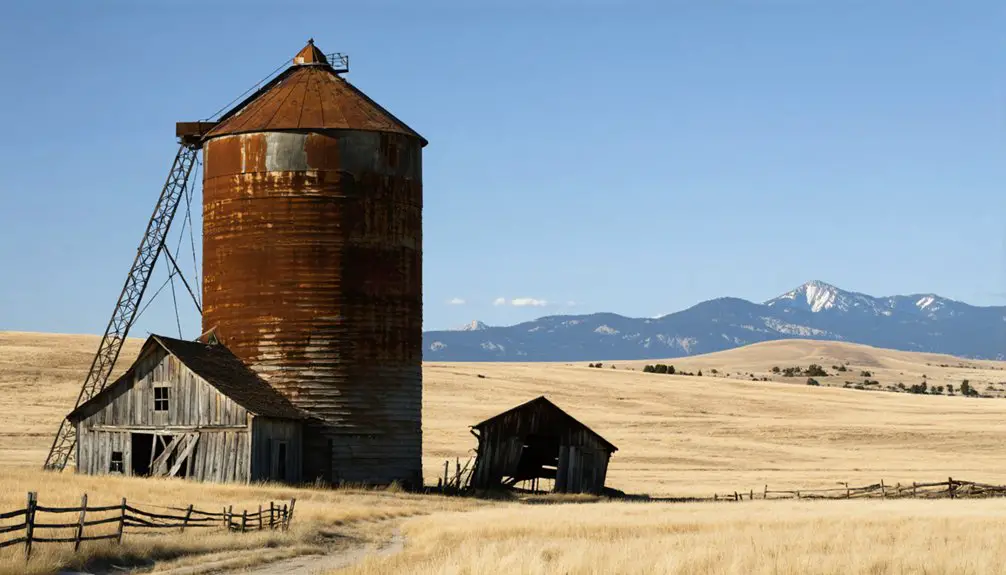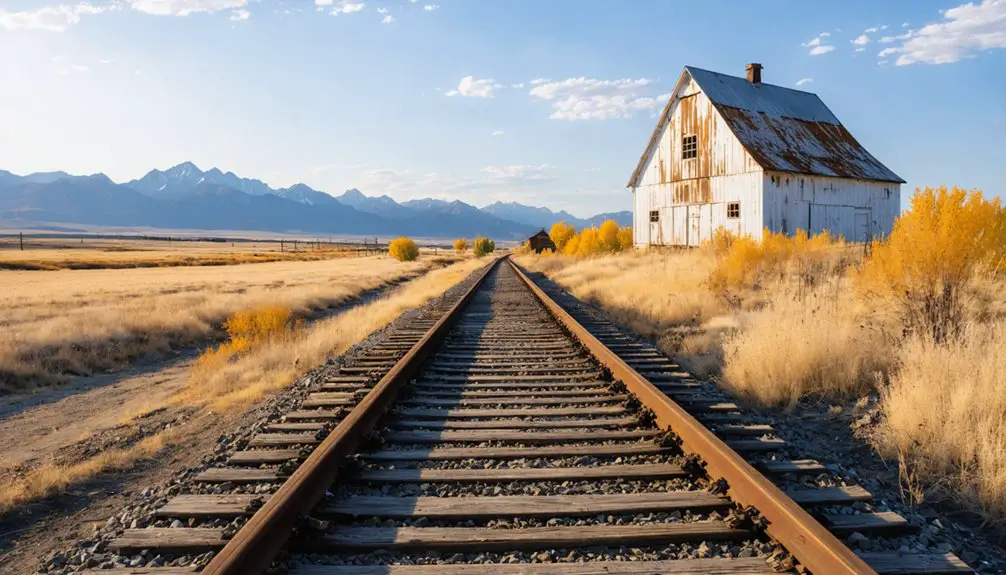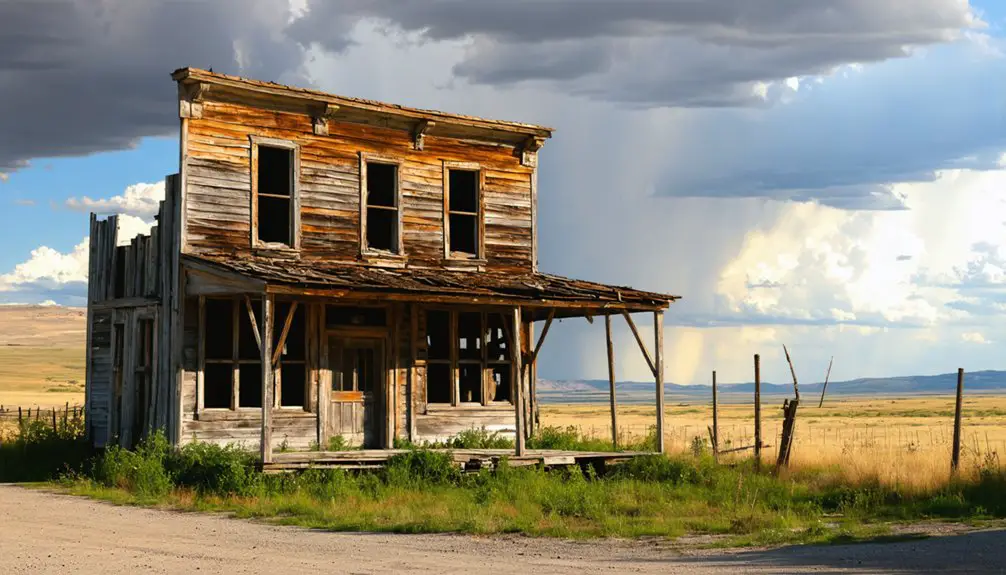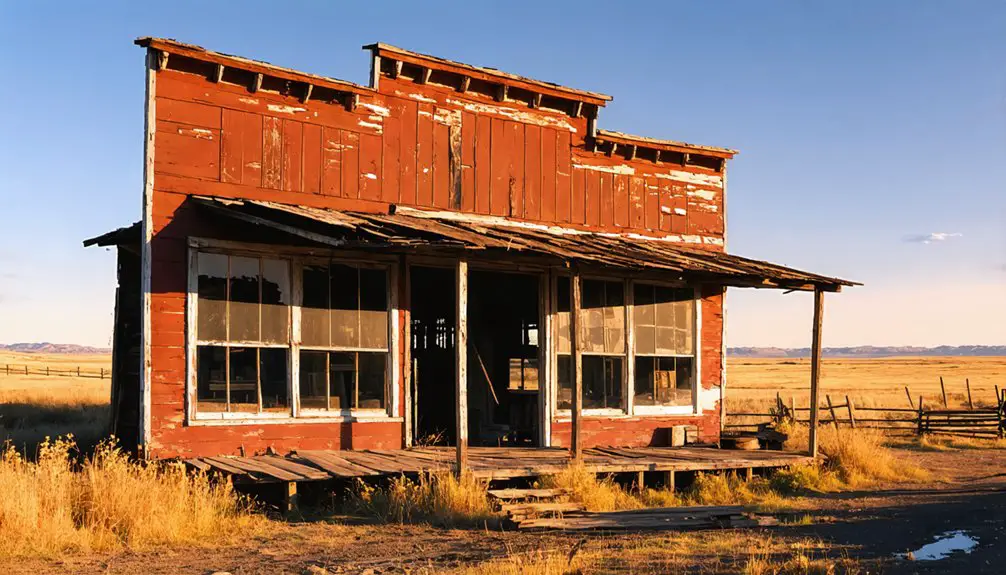You’ll find the ghost town of Bowler in Montana’s challenging Pryor Gap, where Jack Bowler established a crucial railroad settlement in the late 1890s. The town flourished briefly as a transport hub connecting Toluca to Cody after the Chicago, Burlington and Quincy Railroad’s arrival in 1901. Despite supporting around 40 families at its peak, harsh conditions, water scarcity, and declining rail operations led to its abandonment. Today, weather-beaten structures tell a compelling story of frontier determination.
Key Takeaways
- Bowler, Montana was established in the late 1890s as a railway settlement, serving as a crucial transport hub between Toluca and Cody.
- Harsh environmental conditions, including limited rainfall and rocky soil, made agriculture challenging for early settlers in Bowler.
- The town’s decline began after 1911 when the Fromberg to Warren railway connection reduced Bowler’s importance as a transportation hub.
- At its peak, Bowler maintained a population of approximately 40 families before economic pressures and water scarcity led to abandonment.
- Original building foundations and period architecture remain today, preserving the ghost town’s frontier-era authenticity without modern utilities.
The Birth of a Railroad Settlement
As Montana Territory expanded its rail network in the early 1890s, railroad settlements began springing up at strategic points along newly constructed lines.
You’ll find that railroad innovation transformed Montana’s landscape, with towns strategically positioned at division points and junctions to serve both operational needs and regional commerce. Montana Central Railway enabled mining and industrial growth by connecting major hubs like Great Falls, Helena, and Butte.
The settlement dynamics of these railroad towns followed a distinct pattern you can still trace today. When rail companies invested in new locations, they’d often plat entire townsites from scratch, as they did with Kalispell in 1891.
Sometimes existing settlements would lose out – just look at Demersville, whose residents literally picked up their buildings and moved them to the railroad’s chosen location.
Rail development brought not just tracks but also commercial opportunities, government services, and the promise of growth to these strategic points along Montana’s expanding rail system. The arrival of the Northern Pacific Railway in 1871 initiated this transformative period, fundamentally reshaping Montana’s settlement patterns.
Jack Bowler’s Legacy and Early Days
The story of Bowler, Montana begins with its namesake Jack Bowler, who established this agricultural settlement in Carbon County during the late 1890s.
As Bowler’s founder, he chose a strategic location near the Pryor Mountains, creating a crucial community hub for the region’s early pioneers. Standing at six feet tall, Bowler was an imposing figure who commanded respect among the settlers. The settlement quickly gained importance with the establishment of a post office in 1894, which would serve the area’s communication needs for over four decades.
You’ll find that Jack Bowler’s settlement legacy lives on through historical records and remnants of the original townsite, documented in U.S. Geological Survey maps.
The community represented the quintessential frontier spirit, maintaining its rural character while providing essential services like a local bar and cemetery. Like many Montana settlements of its era, Bowler faced the challenges of harsh winter temperatures that could plunge to -40°F.
Life Along the Sagebrush Plains
You’ll find the early homesteaders of Bowler faced harsh realities amid the sagebrush plains, where the mesic soils and 15-35 inches of annual precipitation barely sustained their attempts at dry farming between 1,844 to 3,200 meters elevation.
The scattered families persisted through frigid winters and scorching summers, managing livestock on the vast expanses of mountain big sagebrush and western wheatgrass that characterized Montana’s high steppe environment. The native sagebrush ecosystem supported 357 vertebrate species that the settlers regularly encountered in their daily lives. The deep-rooted bunchgrasses covering the plains created stable drainage ways that prevented erosion during spring runoff.
Your great-grandparents’ generation clung to dreams of prosperity when the railroad promised to transform their remote outpost into a bustling community, though the harsh realities of the plains would ultimately decide Bowler’s fate.
Early Homesteading Challenges
Life along Montana’s sagebrush plains presented early Bowler settlers with formidable challenges, from the rocky soil at Big Pryor Mountain’s base to the constant struggle for water.
You’d find homesteading techniques constantly evolving as settlers adapted to the harsh realities of limited rainfall and short growing seasons.
Without proper irrigation, you couldn’t expect much from the stubborn earth. Settlers hauled logs from distant mountains just to build basic shelters, while pioneering crop adaptations to survive the unforgiving climate. Dry land farmers struggled to make ends meet by borrowing heavily for equipment and fertilizers. Many settlers experienced extreme social isolation due to vast distances between homesteads.
When traditional farming failed, many turned to livestock grazing on surrounding sagebrush areas. The introduction of 320-acre claims acknowledged what you’d already know if you’d worked this land – it took far more acreage to sustain a family in Montana’s arid conditions than lawmakers initially believed.
Railroad Community Dreams
When surveyors mapped the railway route through Bowler in spring 1899, they sparked fresh hopes for prosperity along Montana’s sagebrush plains. Your railroad dreams would’ve seemed within reach as construction crews carved through Pryor Gap, laying tracks that promised to slash freight costs and connect you to distant markets.
By 1901, the line linking Toluca to Cody transformed Bowler into a crucial transport hub. Your daily routine would include watching trains crawl at 25 to 30 mph through the challenging terrain. Just like the Northern Pacific Railway had done in Billings, this new line brought an economic boom to the region.
- You’d spot grain elevators rising against the prairie sky, ready to store your harvest for shipment to urban markets.
- You’d find steady work maintaining tracks or loading freight cars with ranch products and agricultural goods.
- You’d witness your isolated homestead transform into a bustling community where trains brought mail, supplies, and new neighbors.
The Rise and Fall of Railway Operations
You’ll find that railway construction near Bowler faced significant challenges with the steep Pryor Gap grades, particularly around the northern tunnel section completed in 1901.
The line’s operational inefficiencies became apparent through slower train speeds and difficult terrain management compared to other regional routes.
Your understanding of the railway’s eventual decline should note how these physical obstacles, combined with the opening of the more efficient Fromberg to Warren connection in 1911, led to the route’s diminished importance and ultimate abandonment.
Railway Construction Challenges
Despite the promise of economic growth, the railroad construction through Bowler, Montana, faced formidable challenges from its initial survey in spring 1899. The mountainous terrain through Pryor Gap demanded innovative engineering solutions, while labor disputes and harsh working conditions slowed progress.
You’ll find that construction crews battled severe weather, complex geography, and limited technology while building bridges across major rivers and tackling steep mountain grades.
Three key challenges that shaped Bowler’s railway development:
- The difficult grade through Pryor Gap required extensive earthworks and a challenging tunnel.
- Worker camps struggled with inadequate housing and medical care, especially affecting Chinese laborers.
- Economic downturns and competition forced strategic route changes and eventual abandonment of some lines.
Inefficient Train Service Problems
Although Bowler’s railway service promised economic significance for the region in 1901, operational inefficiencies quickly plagued the line until its abandonment in 1911.
You’d have found limited train frequency through Montana’s challenging mountain terrain, with services running only a few days per week. Poor track conditions and deferred maintenance led to slower speeds and frequent delays.
Infrastructure challenges mounted as aging lines deteriorated without proper investment. You couldn’t count on reliable schedules, as weather disruptions and inadequate rolling stock hampered daily operations.
The railway couldn’t compete with emerging automobile and truck transportation, which offered greater flexibility for both passengers and freight. Insufficient funding for track upgrades, coupled with declining agricultural shipments and passenger numbers, ultimately sealed the fate of Bowler’s short-lived rail service.
Agricultural Challenges in Pryor Gap

While the Pryor Gap region once thrived with agricultural activity, farmers and ranchers now face mounting challenges that threaten their operations’ sustainability.
You’ll find economic pressures squeezing local producers as land prices soar and equipment costs drain savings. Water management has become increasingly vital with declining mountain snowpack limiting irrigation for essential crops like hay and sugar beets.
- Rising temperatures above 90°F are stressing both crops and livestock, while forcing increased irrigation demands.
- The competition between wild horse populations and cattle for grazing land creates complex management challenges.
- Young ranchers can’t afford to maintain generational farms, leading to land fragmentation.
You’re witnessing a transformation where traditional farming practices struggle against climate change, financial strain, and resource competition.
Natural Resources and Environmental Impact
You’ll notice Bowler’s harsh terrain around the ghost town reflects the challenging conditions that plagued early settlers, with the rocky mining-scarred landscape making agriculture nearly impossible without extensive irrigation.
The railroad’s attempts to navigate the difficult topography ultimately proved futile, as the steep grades and unstable ground near the old mine workings created constant maintenance issues.
Water scarcity compounded these problems, as the altered drainage patterns from mining activities and the naturally arid climate of Bowler Flats forced reliance on carefully managed irrigation systems now overseen by Newmont Resources Corporation.
Water Scarcity Issues
Water scarcity played a decisive role in Bowler’s transformation into a ghost town by the late 1930s. The farming community on Bowler Flats struggled with insufficient water supplies, while a rock dam on Sage Creek proved useless due to persistent shortages.
Water rights disputes intensified throughout the 1920s and 1930s, ultimately contributing to the community’s collapse, marked by the post office’s closure in 1936.
Today’s challenges mirror Bowler’s irrigation struggles, with Montana facing exceptional drought conditions:
- River flows have dropped to one-fifth of typical volumes, severely impacting agricultural operations.
- Climate change is accelerating water scarcity at unprecedented rates, ten times faster than natural warming.
- The outdated water rights framework fails to address modern challenges, leaving many residents vulnerable to shortages.
Terrain and Railroad Challenges
The challenging terrain of Bowler, Montana shaped not only its water struggles but also its railway development in the early 20th century.
You’ll find the area’s geological features defined by the Nye-Bowler Fault Zone, where ancient tectonic forces created a complex landscape of folds and faults stretching over 100 miles.
Railroad builders faced formidable obstacles in Bowler Flats’ rocky soil, where terrain stability concerns demanded extensive surveying.
They’d encounter scattered boulders, sudden buttes, and active fault lines that complicated track laying.
The limited local resources didn’t help – while nearby stone served as ballast material, the scarce timber and water supplies hindered construction efforts.
As tracks finally cut through this rugged land, they forever altered the natural drainage patterns and wildlife corridors of the Pryor Mountains ecosystem.
Transportation Networks and Regional Connections

While isolated frontier settlements often struggled with transportation access, Bowler’s connectivity evolved markedly between 1895 and 1911.
Before the railroad’s arrival, you’d have made the arduous journey to Billings just to collect mail. The Chicago, Burlington and Quincy Railroad transformed regional trade in 1901, establishing Bowler as an essential link between Billings and the Big Horn Basin.
The railroad’s 1901 arrival freed Bowler residents from grueling mail runs, transforming the town into a vital regional hub.
- Early stagecoach routes connected you to mining towns, though you’d often dismount to push coaches uphill.
- The railroad’s arrival meant you could ship agricultural supplies and receive goods more efficiently.
- A network of roads, including Bridger Canyon Road, let you reach neighboring ranches and communities.
The transportation evolution brought brief prosperity until the railroad’s abandonment in 1911 forced a return to slower methods.
The Final Years of a Frontier Community
As mining profits plummeted across Montana’s frontier settlements in the late 1880s, Bowler’s once-thriving community began its rapid descent into abandonment.
You’d have witnessed dramatic economic shifts as major operations like Alta Montana Mining failed, while the Helena and Livingston Smelting and Reduction Company’s takeover proved futile against mounting costs and depleted ore.
The community dynamics shifted violently during these final years.
You’d have seen vigilante justice replace formal law enforcement, with controversial hangings and social unrest tearing at the town’s fabric.
As miners and their families fled the failing economy, Bowler’s population dwindled to just a handful of hardy souls.
Remnants of the Past: What Survives Today

Today’s visitors to Bowler’s abandoned streets find a markedly different scene from its tumultuous final years.
The weather-beaten structures stand as silent sentinels to Montana’s frontier past, with original log and clapboard buildings slowly yielding to nature’s reclamation.
You’ll find authentic period architecture throughout the ghost town, carefully preserved without modern utilities to maintain historical accuracy.
- Original building foundations and street layouts remain intact, offering you a genuine glimpse into frontier town planning.
- The rugged mountain wilderness and seasonal extremes create an immersive historical preservation experience.
- You’re free to explore preserved interiors containing period-specific artifacts, from mining equipment to household items.
As an indication of ghost town tourism, Bowler’s remaining structures tell compelling stories of Montana’s gold rush era through their weathered walls and carefully curated displays.
Historical Significance in Montana’s Development
Although Bowler’s existence was relatively brief, this frontier settlement played a pivotal role in Montana’s territorial development from 1892 to 1936.
You’ll find Bowler’s story reflects the broader patterns of railroad expansion that shaped Montana’s early communities, serving as an essential link between Billings and the Bighorn Basin during a critical period of western settlement.
As a transport hub connecting stage routes and the CB&Q railroad line, Bowler demonstrated remarkable community resilience in the face of harsh environmental challenges.
Despite water scarcity and agricultural limitations, the settlement persisted for over four decades, supporting roughly 40 families at its peak.
While Bowler ultimately succumbed to economic pressures and natural constraints, its legacy illuminates the complex interplay between transportation networks, environmental factors, and frontier community survival in early Montana.
Frequently Asked Questions
What Native American Tribes Originally Inhabited the Bowler Flats Area?
You’ll find the Crow tribe was the primary inhabitant of Bowler Flats, while Blackfeet, Cheyenne, Assiniboine, and Gros Ventre tribes shared cultural significance and tribal history in surrounding territories.
Were There Any Notable Crimes or Lawlessness in Bowler’s Early Days?
You won’t find documented crime statistics or major lawlessness cases from Bowler’s early days. Its small agricultural population and limited law enforcement presence suggest a relatively peaceful rural settlement compared to nearby mining towns.
What Happened to Jack Bowler After the Town’s Decline?
Like a fading prairie sunset, you can’t trace Jack Bowler’s final years in historical records. After Bowler’s decline in the 1930s, his legacy simply vanishes into Montana’s vast frontier story.
Did Any Famous Historical Figures Ever Pass Through Bowler?
You won’t find documented evidence of famous visitors in Bowler’s historical records. While the town’s railroad and stage stop could’ve attracted notable travelers, its historical significance remains tied to local development.
Are There Any Ghost Stories or Local Legends Associated With Bowler?
You’ll find few documented haunted locations in Bowler, though local folklore suggests ghostly sounds of train whistles and horse carriages echo through the abandoned settlement’s crumbling remains after dark.
References
- https://southwestmt.com/blog/ghost-town-terror-gunslinger-gulch/
- https://passionsandplaces.com/elkhorn-montana-ghost-town/
- https://www.geowyo.com/nye-bowler-fault-zone.html
- https://www.youtube.com/watch?v=YU0y9_5Ylbg
- https://www.atlasobscura.com/places/elkhorn-ghost-town
- http://mmrh.org/mt_rr_history.html
- https://en.wikipedia.org/wiki/Montana_Central_Railway
- https://mhs.mt.gov/Shpo/docs/KalispellWalkTour.pdf
- https://montanahistoriclandscape.com/2014/07/27/nashua-montana-stories-of-a-railroad-and-a-man/
- https://www.mtmemory.org/nodes/view/116034



